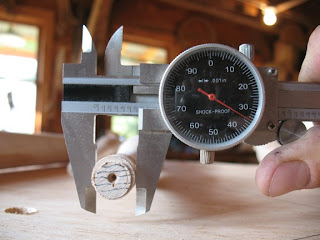When I first read about working with green wood, I recall being overwhelmed by all the talk of equilibrium moisture content, tangential to radial shrinkage ratios and wet dry hygrometers. Clearly, you need an advanced degree to sidestep the lumberyard and work with green wood!
Of course, in time, I came to understand what all of those things mean, but most importantly, I came to recognize that there are a few common sense pieces of information that can replace them.
The basic notion has two parts,
Part 1. Wood has moisture in it and shrinks as the moisture exits and swells when it comes in.
Part 2. Wood shrinks more along the growth rings than it does across them. This is why becomes oval when turned green.
I used to split all my turning stock green and immediately turn my chair parts, leaving the tenon ends oversized. Then I'd dry the tenon ends and re-turn the final tenons once the wood stopped shrinking. Now I prefer to rough out all my stock green, then air dry it in my shop for anywhere from a few weeks to, well, forever.
This gives me less warping and distortion after turning, a slightly better surface quality and less waiting time for the tenons to be superdried once they are rough sized. After the rough sized tenons are superdried, I chuck the turnings back in the lathe and take them down to the final size, removing just a few thousandths of an inch to get there.
So what are these magic numbers!? These numbers are the amount that I oversize a tenon based on the moisture in the wood. I know to expect a certain amount of shrinkage once the tenon goes in the kiln, and if I don't leave enough extra material, I won't have enough wood left to turn to the final size.
So let's say that I'm using a 5/8" mortise, which translates to .625". If the stock is green, I assume that the tenon will shrink along the growth rings (tangetial plane) about 60 thousandths of an inch, so I oversize the tenons by turning them to .695" or .700"(notice that I've added a little extra). The beauty in doing this green, is that you can estimate the shrinkage accurately. Because it hasn't even begun to shrink, it will be the same every time.
When using air dried stock, I oversize the tenons from 25 to 35 thousandth. So depending on how long the stock has been sitting around drying, I turn the tenons to .660" or .650". In the image above, I am measuring the tenon along the growth rings (tangentially), which I drew in pencil. This is the plane that shrinks the most. This tenon was turned at .655" and you can see that it has shrunk to .635". To me, this is close to ideal.
Here is the radial plane, and as you can see, it shrank much less, only 5 thousandths of an inch or so, which is to be expected. I am showing you this to knock home the idea that it matters a great deal which way you measure your tenons. Once you've done it a couple times, you'll get and get used to measuring them in the two orientations, then you can accurately tell when they've stopped shrinking and are ready to be final sized and assembled.
At first, it's reasonable to oversize the rough tenons too much, but with time, you'll get the rhythm and get closer to the final size. By the way, I have a special drill bit that I ground for those "special" tenons that shrink more than expected. Good luck!












